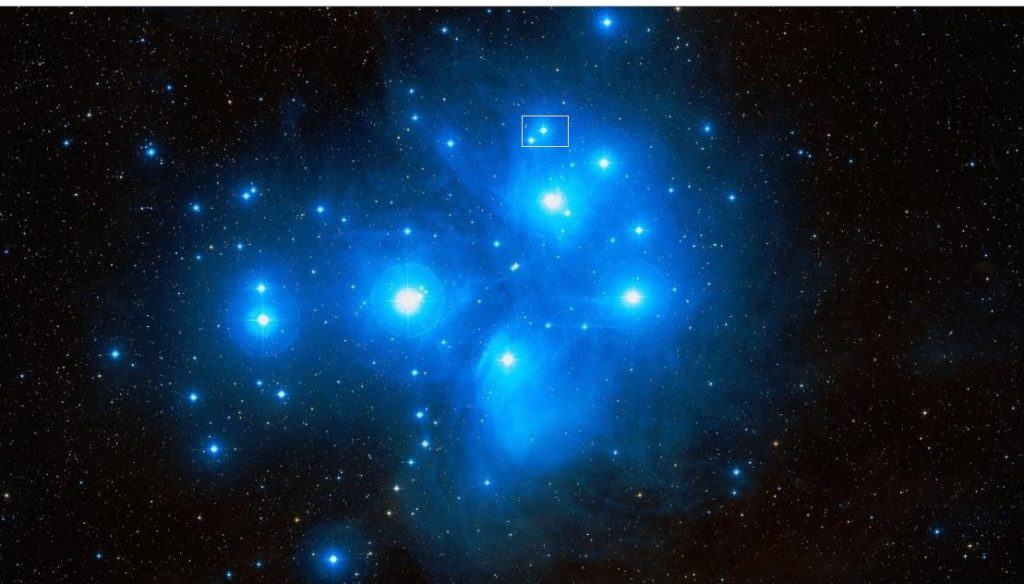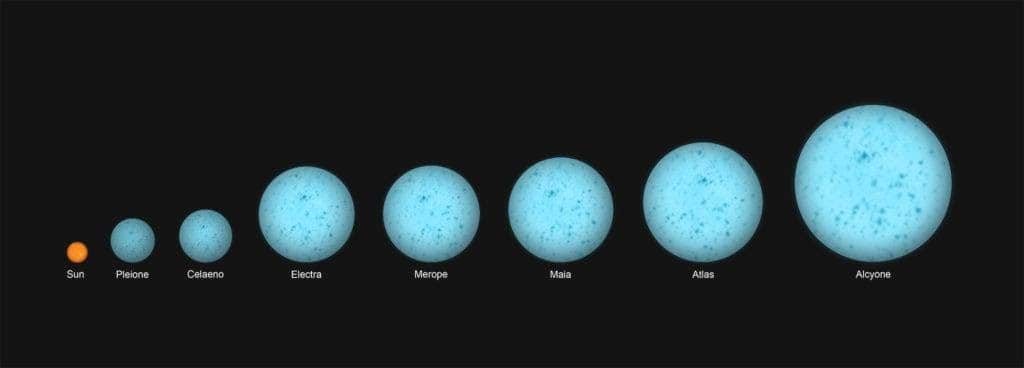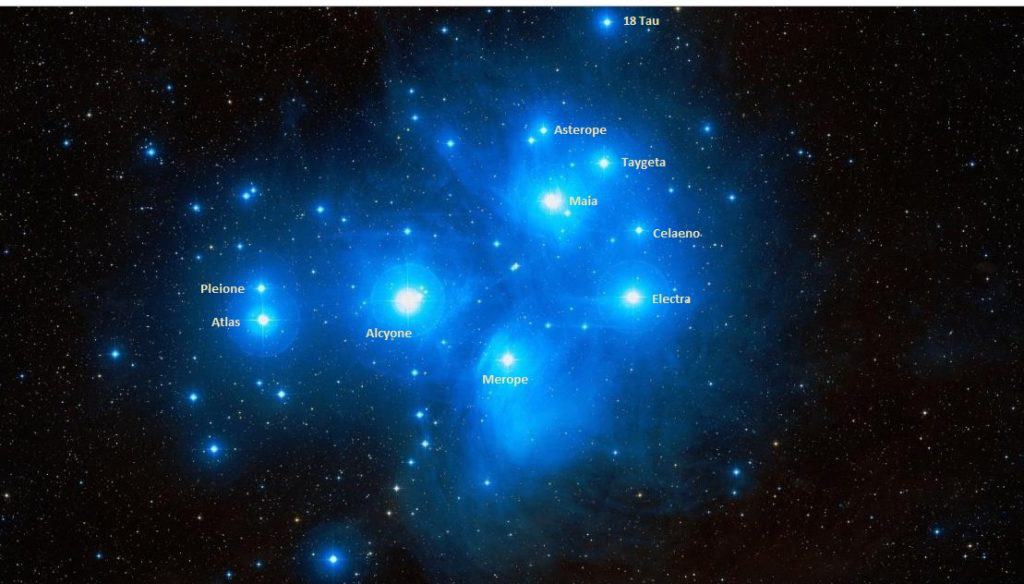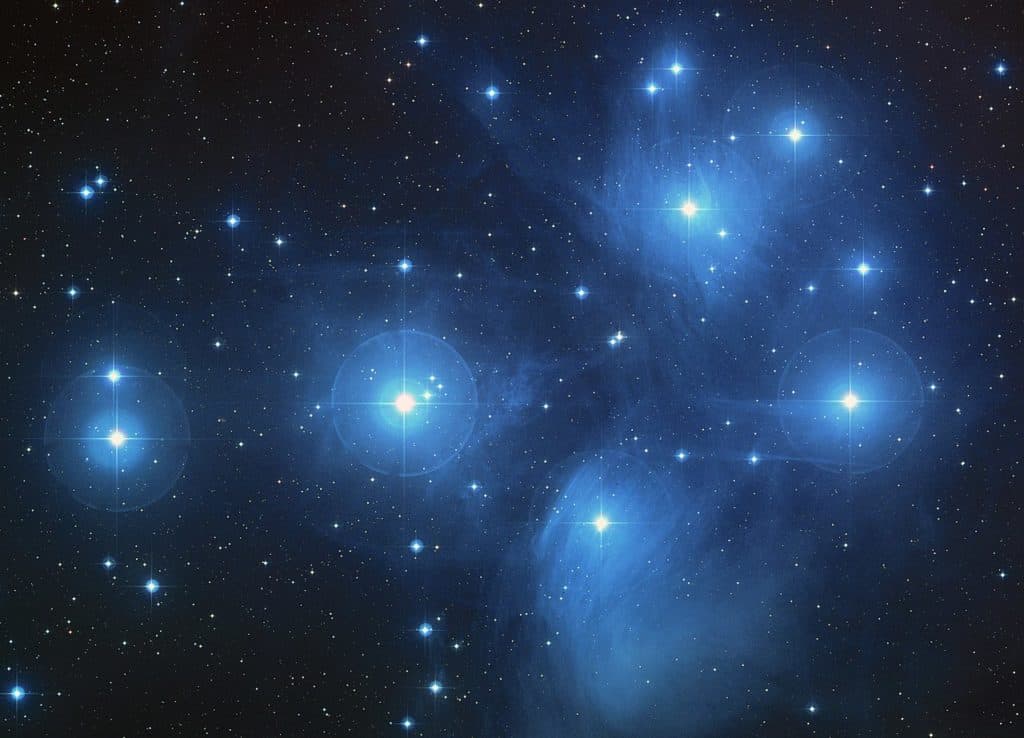Asterope, designated as 21 Tauri, is a double star in the Pleiades Open Cluster, located in the zodiacal constellation of Taurus, the celestial bull.
Key Facts & Summary
- Asterope is situated at around 431 light-years away from our Sun. The stars are moving further away from us with a heliocentric radial velocity of +6 km / +3.7 mi per second.
- Asterope has an apparent magnitude of 5.76. It is visible to the naked eye, however, only in favorable conditions.
- Asterope is part of a double-star system that is sometimes referred to as Sterope I and Sterope II, or 21 Tauri and 22 Tauri. The two stars are close to each other, separated by only 2.82 arcminutes.
- They appear as a single elongated object, and since they are close, it contributes to their overall brightness.
- The primary star, Asterope, is a blue-white main-sequence star, with the stellar classification B8V.
- Asterope has 2.93 solar masses, however, its radius and diameter are unknown. Since it is more massive than our Sun, it is most likely also bigger.
- The estimated age of Asterope is around 100 million years – much younger than our Sun.
- Asterope has an absolute magnitude of 0.34.
- Asterope is around 100 times brighter than our Sun.
- It is also hotter than our Sun, with surface average temperatures reaching around 11,000 K.
- The surface gravity on Asterope has bee estimated at 4.2 cgs.
- Asterope is a fast-spinning star, having a rotational velocity of 159 km / 98.7 mi per second.
- The zodiacal constellation of Taurus and the Pleiades are so bright and distinguishable, that humanity has known them for thousands of years.
- The Pleiades cluster though very bright, cannot be seen during May and June since the Sun blocks our view of the cluster in that period.
Asterope was one of the Pleiades sisters in Greek mythology. They were the daughters of the Titan Atlas and the Oceanid nymph, Pleione. Some sources state that Asterope was either the wife of King Oenomaus of Pisa or his mother by the god Ares.

The star’s name, Asterope, translated from Greek would mean “lightning.” This name formally applies only to the component 21 Tauri A, and it was approved by the IAU in 2016.
Formation
Asterope, along with its neighboring stars in the Pleiades cluster, formed between 75 and 150 million years ago. This open cluster is among the closest star clusters to Earth.
All the stars in the Pleiades cluster have a common origin, they formed through a gigantic molecular cloud of dust and gas. Gravity pulled the swirling gas and dust together and formed the Pleiades cluster.
Some sources state that Asterope formed quite recently (in comparison to our Sun), more exactly, 100 million years ago. The Pleiades cluster is overall dominated by very hot blue and luminous stars.
Distance, Size, and Mass
Asterope is situated at around 431 light-years / 132 parsecs away from the Sun. Much of its physical characteristics and that of its companion remain unknown.

However, what has been estimated, is Asterope’s mass. This star has around 2.93 solar masses or 293% of the Sun’s mass. Given its mass, the star should be several times bigger than our Sun.
Its companion has an estimated radius of 3.1 or 310% of the Sun’s radius.
Other Characteristics
Asterope is a blue-white B-type main-sequence star with a stellar classification of B8V. Asterope is around 100 times brighter than our Sun, and its surface average temperatures have been estimated at 11,041 K, it is thus 1.9 times hotter than our Sun.
Asterope has an apparent magnitude of 5.76. It is visible to the naked eye, however, only in favorable conditions. Asterope is also a fast-spinning star, having a rotational velocity of 159 km / 98.7 mi per second. However, its companion, 22 Tauri, is faster.
22 Tauri is a white main-sequence star of spectral type A0Vn. It is only 6.36 times brighter than our Sun, and a little hotter, with temperatures at 11,817, thus it is 2 times hotter than our Sun.
The rotational velocity of 22 Tauri is 232 km / 144 mi, much faster than Asterope. Its apparent magnitude is 6.43, which is in the lower limit for naked-eye visibility.
Stellar System
Asterope is part of a double-star system sometimes referred to as Sterope I and Sterope II or 21 Tauri, and 22 Tauri. The two stars are separated from one another by 2.82 arcminutes, and they appear in the sky as a single elongated star of magnitude 5.6.

Asterope shows excess emissions in the infrared due to the presence of a reflection nebula that surrounds it. Sterope is moving away from us with a heliocentric radial velocity of +6 km / +3.7 mi per second.
Location
Both Asterope, or 21 Tauri, and 22 Tauri are located in the zodiacal constellation of Taurus, the celestial bull. They are among the brightest stars of the famous Pleiades open cluster. The Constellation of Taurus is also home to another great open cluster named Hyades.

This constellation is among the largest in the night sky, and also one of the most prominent of the northern constellations occupying an area of 797 square degrees.
The constellation of Taurus, apart from the two mentioned clusters, also has many interesting stars such as Aldebaran, Elnath, and also other fascinating deep-sky objects such as the Crab Nebula, Crystal Ball Nebula, merging galaxies and many more open clusters.
These celestial objects are best observed and studied during January.
Pleiades Member
Asterope, or 21 Tauri, and along with 22 Tauri are among the brightest stars/members of the Pleiades open cluster. From October to April, these stars can be observed and studied, however, May and June are not suitable for observation since the cluster is too close to the Sun.
The Pleiades open cluster is among the closest star clusters to Earth, and one of the brightest in our vicinity. Though the cluster is very bright and easy to find, you may also draw an imaginary line from the stars of Orion’s Belt – Alnitak, Alnilam, and Mintaka – past Aldebaran – and find the cluster.

The Pleiades cluster is also known as Messier 45. The majority of the brightest and hottest stars here are of spectral class B, and they formed between 75 and 150 million years ago.
Most of them are far apart from each other, and at around 444 light-years away from us. The most documented and famous stars are all named after the mythological Seven Sisters and their parents from Greek mythology.
The nine stars are Alcyone, Asterope, Atlas, Electra, Celaeno, Maia, Merope, Taygeta, and Pleione. The mythological story depicts the sisters as they caught the eye of Orion, a giant huntsman. Atlas, being condemned for his battles against the gods, was condemned to carry the heavens on his shoulders while Orion, the giant, pursued his daughters.

However, the Greek god Zeus stepped in and transformed the sisters into doves, and then into stars to console their father. Even so, Orion, the giant, is still pursuing the Pleiades sisters across the sky, represented by the Orion constellation.
The Future
Alcyone will continue to exist for many millions of years however, the Pleides star cluster has been studied closely and many computer simulations predict a grim future.
Most simulations suggest that the cluster will continue to survive for 250 million years before it will start to disperse due to gravitational interactions with its galactic neighborhood.
Did you know?
- The Chinese people know Asterope as the Third Star of Hairy Head – Hairy Head being an asterism formed by the Pleiades stars Asterope, Atlas, Electra, Maia, Merope, Taygeta, and Alcyone. It is one of the seven mansions of the White Tiger.
- The Pleiades star cluster is believed to have been formed from a compact configuration that resembled the Orion Nebula.
- Many cultures throughout the world knew of the Pleiades cluster since ancient times. One of the earliest depictions of the Pleiades cluster and its stars resides in the Nebra sky disk – a Bronze Age artifact dating to 1.6000 BCE, uncovered in Germany.
- Many famous and ancient texts mention the cluster, such as Homer’s Illiad and Odyssey, Hesiod’s Works and Days, the Bible, the ancient Egyptian Calendar of Lucky and Unlucky Days, and the Japanese Kojiki – An Account of Ancient Matters – the 8th-century chronicle of myths, oral traditions, and legends.
- The Pleiades are mentioned in the Kojiki as the Mutsuraboshi – translating to “six stars.” In modern Japan, the cluster is now known as Subaru – the same name used by the famous automobile company that depicts the six brightest stars in their logo.
- One of the first telescopic observations conducted on the Pleiades was during the 1610s. Galileo Galilei observed the bright stars and the cluster and it is noted that he may well be the first to have done so.
Sources:
Image sources:
- https://www.star-facts.com/wp-content/uploads/2019/11/Asterope.jpg?189db0&189db0
- https://www.star-facts.com/wp-content/uploads/2019/11/Sterope-I-and-Sterope-II.jpg?189db0&189db0
- https://www.star-facts.com/wp-content/uploads/2019/10/Taurus-constellation.jpg?189db0&189db0
- https://www.star-facts.com/wp-content/uploads/2019/11/Pleiades.jpg?189db0&189db0
- https://www.star-facts.com/wp-content/uploads/2019/11/Pleiades-cluster.jpg?189db0&189db0
